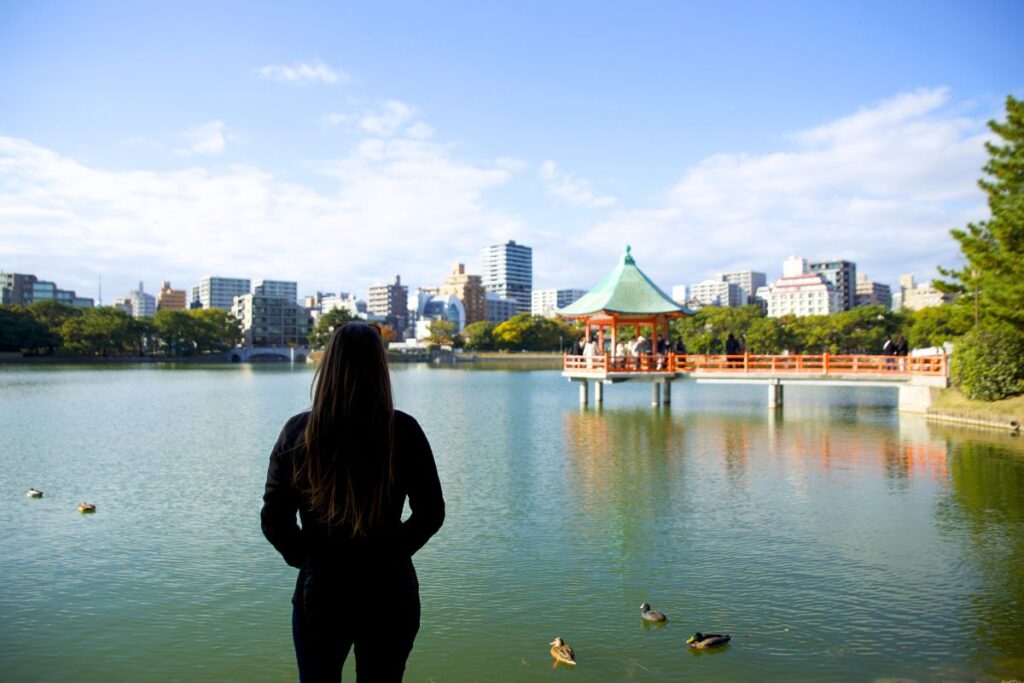
Last updated on March 2, 2024 by Krysti
Are you in search of the perfect Fukuoka itinerary? Then look no further! Because I’ve got you covered with this epic guide to 3 days in Fukuoka!
Known for its rich history, incredible cuisine, beautiful natural surroundings, and lively nightlife, Fukuoka is an unforgettable destination that simply shouldn’t be missed.
In fact, since moving to Japan, it’s become my favorite city – and one that I keep returning to!
There’s just so much to do and see here. And the best part is, it isn’t super crowded like many of Japan’s more popular cities.
So, what exactly should you do when you visit Fukuoka? When should you go? And what should you prioritize?
We’ll discuss all of this and more as we plan out the best Fukuoka itinerary for 3 days!
Best Time to Visit Fukuoka
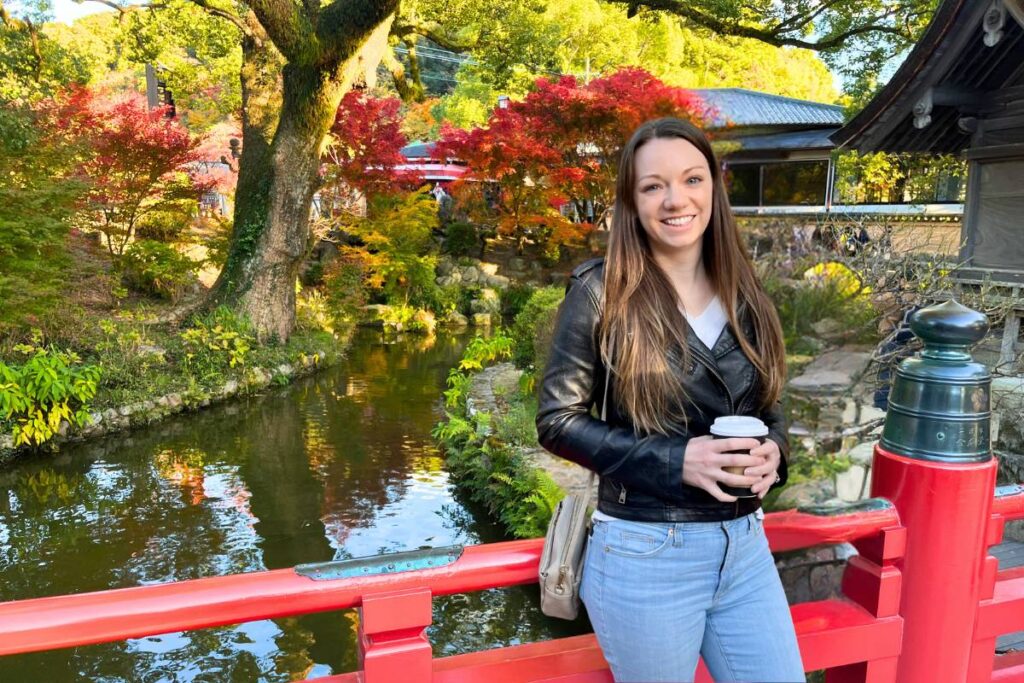
Autumn is a great time to visit Fukuoka!
Given its location in southern Japan, Fukuoka is an incredible destination to visit year-round!
Even in the height of winter, temperatures here rarely fall below 50°F (10°C) during the day. So you can usually expect to find mild and mostly pleasant weather.
In addition to this, the city experiences significantly fewer typhoons when compared to the rest of the country. So, there isn’t as much of a risk here when it comes to travel disruptions.
That being said, each season does bring with it its own set of perks and benefits. So it’s important to keep that in mind and plan according to your interests.
Spring: If you’re hoping to see cherry blossoms, then spring is, without a doubt, the best time to visit Fukuoka. Cherry blossoms here usually peak towards the end of March and the beginning of April; however, it can vary slightly from year to year. Temperatures around this time are typically mild, with bright, sunny days and minimal rain.
Summer: The summer season in Fukuoka can be quite hot and humid. However, Fukuoka is home to some pretty incredible beaches. So, if you’re a fan of the ocean and enjoy the beach, summer is the perfect time to visit. Just be aware you may experience some rain. While June and July are usually the rainiest months in Fukuoka, July and August are typically the hottest months.
Fall: During the fall, Fukuoka explodes with color. So, if you love autumn foliage, this is undoubtedly the best time to visit the city. Since Fukuoka is located in the south, fall leaves here typically don’t peak until later in the year – usually around late October into November. In terms of weather, you can expect mild and pleasant temperatures with minimal rain.
Winter: If you don’t mind a bit of cold weather here and there, then winter is a great time to visit Fukuoka. Not only is it typically less crowded, but the city comes to life with holiday illuminations and Christmas markets. These usually begin around late November and run through the New Year. Temperatures around this time are the coolest but are still mild and manageable.
A Note on Japanese Holidays
Japan has a few major national holidays that significantly impact travel. These include Golden Week (end of April – beginning of May), Silver Week (mid-September), and New Years.
During these holiday periods, domestic travel peaks, prices increase significantly, and businesses may temporarily close down. Given this, I generally recommend, if at all possible, that visitors avoid travel to Japan around these holidays.
How to Get to Fukuoka
The city of Fukuoka is nestled along the northern coast of Japan’s third largest island, Kyushu Island.
Although Kyushu lies just south of the main island of Honshu, the two are connected by a series of bridges. As such, it’s possible to fly, drive, or take a train down to Fukuoka.
If you opt to travel by plane, you’ll want to fly into Fukuoka Airport (FUK). This is an international and domestic airport that’s located right within the city.
Direct flights to Fukuoka are offered from several destinations, including Tokyo, Osaka, Okinawa, Seoul, Hong Kong, and even Honolulu.
Alternatively, you can also take a train or bullet train to Fukuoka, depending on where you’re coming from.
While there are a few train stations in Fukuoka, Hakata Station is the main station for the city.
How to Get Around Fukuoka
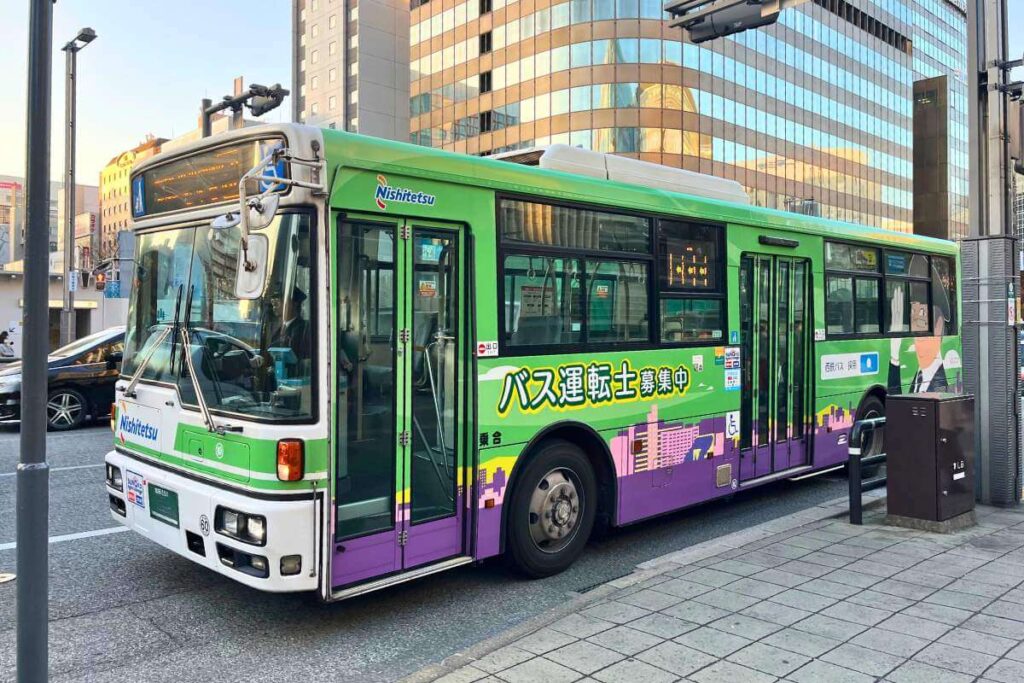
Public transportation is so reliable & convenient in Japan!
Once you arrive in Fukuoka, you’ll find that it’s very easy to get around the city.
Public transportation is widely available, affordable, and convenient, as the city offers an extensive network of buses, trains, and subways. This network covers most of the city and much of the surrounding areas.
In order to access this public transit service, you’ll need to purchase a transportation pass, also known as an IC card.
These prepaid, refillable cards can be found at train stations and are compatible across most forms of public transportation throughout Japan.
This means that an IC card purchased in Fukuoka can be used for trains, buses, and subways in Fukuoka, as well as Tokyo, Osaka, Kyoto, Hiroshima, etc.
Some exceptions to this, however, include Shinkansen (or bullet trains), limited express trains, and highway buses. These forms of transportation typically require their own separate ticket.
To help you navigate your way through the city, I suggest using Google Maps. This app is one of the best travel apps for Japan, as it syncs with local public transportation and provides accurate, up-to-date transit information.
Pro Tip: iPhone users can use digital IC cards instead of physical ones. Available cards include Suica, PASMO, and ICOCA. You can purchase these cards directly through Apple Wallet or transfer an existing physical card to your account.
Fukuoka Map
To help you plan your trip, here’s a quick map overview of all the destinations mentioned in this 3-day itinerary for Fukuoka.
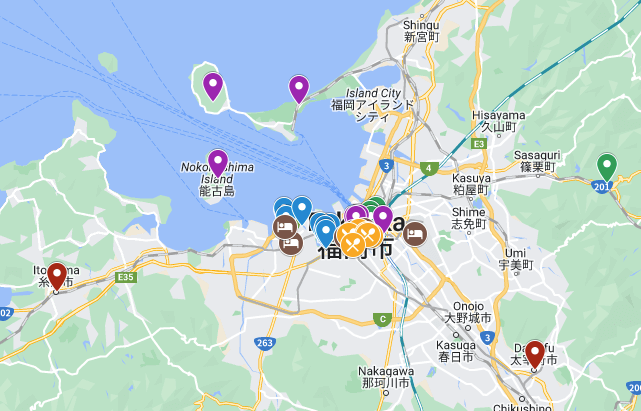
If you’d like to view an interactive version of this map, click here!
3 Days in Fukuoka: A Quick Overview
Don’t have time to read the article in full? Here’s a quick recap of my suggested itinerary for 3 days in Fukuoka.
- Day 1 – Fukuoka City Highlights: Visit Fukuoka Castle Ruins, Ohori Park, Fukuoka Tower/Momochi Seaside Park, and teamLab Forest Fukuoka.
- Day 2 – Fukuoka’s Shrines & Temples: Discover Nanzoin Temple, Tochoji Temple, Kushida Shrine, and Sumiyoshi Shrine. End your day at Canal City Hakata and check out Ramen Stadium.
- Day 3 – Day Trip from Fukuoka: Take a day trip outside of the city and explore a nearby destination. Full list of recommended day trips below!
3 Days in Fukuoka: Explained
On that note, let’s dive in and discuss in detail the perfect Fukuoka itinerary for 3 days. I’ve included a variety of options for you to consider, as well as some alternative activities. Feel free to pick and choose and adapt this itinerary as you see fit!
Day 1: Fukuoka City Highlights
For your first day in Fukuoka, I recommend visiting some of the city’s most popular attractions. There are several for you to choose from; however, don’t feel pressured to see it all. This first day will vary depending on when you arrive in Fukuoka and how much time you have to explore.
Discover the Ruins of Fukuoka Castle

Dating back to the 17th century, Fukuoka Castle was, at one point in time, the largest castle on Kyushu Island.
Serving as the residence for Fukuoka’s ruling nobility, the castle was in use for more than two centuries before it was largely torn down and destroyed at the start of the Meiji era.
Today, the remnants of the castle have been designated a National Historic Site and are open to visitors free of charge.
While many of the castle’s towers and structures are little more than rubble, a few buildings do remain intact, offering a glimpse into Fukuoka’s past.
Stroll Through Ohori Park

Situated next to Fukuoka Castle you’ll find Ohori Park, an expansive green space centered around a large pond.
This pond actually used to serve as part of the castle’s moat system. However, in the early 1900s the entire area was transformed into a public community space.
Today, the park offers a plethora of walking trails, playgrounds, scenic lookout points, as well as access to three small islands.
In addition to this, the area is home to several notable attractions, including the Fukuoka Art Museum, the Ohori Park Japanese Garden, and the Gokoku Shrine.
Take in the Views From Fukuoka Tower & Momochi Seaside Park
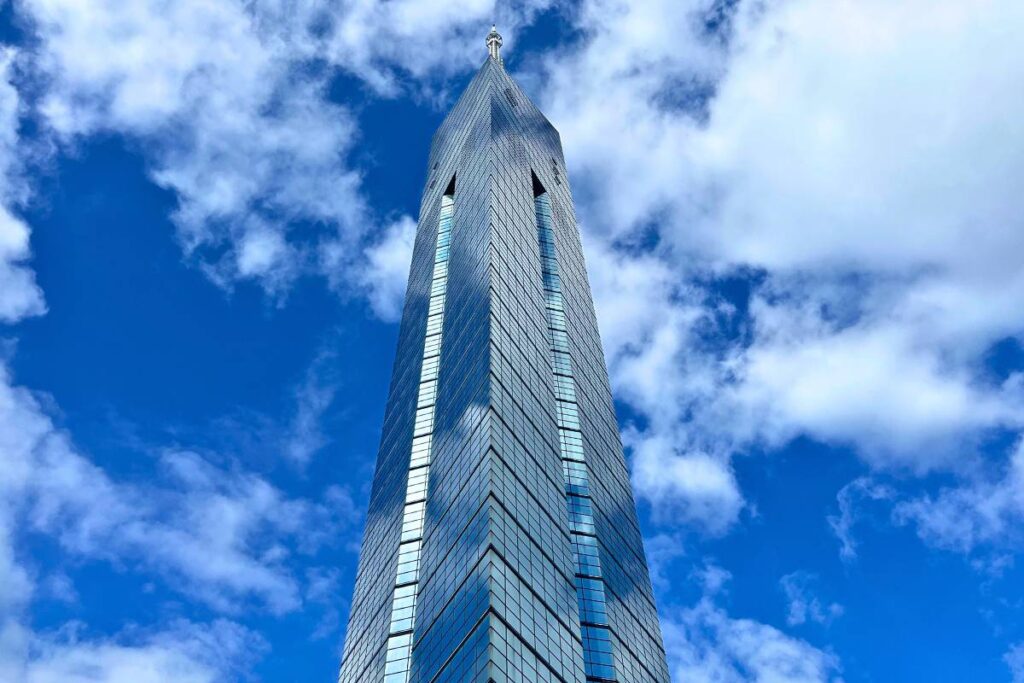
Measuring 234 meters in height, Fukuoka Tower is the tallest seaside tower in Japan. As such, it offers incredible 360° panoramic views of Hakata Bay and Fukuoka City.
There are two observation decks open to visitors here, as well as a third observation floor that is home to a cafe and restaurant.
The tower also happens to be located right next to Momochi Seaside Park, which is an artificial beach along Hakata Bay.
Here, you can explore the beach, jump in the water for a swim, or visit one of the park’s small waterfront eateries.
Pro Tip: If you have extra time to spare, be sure to also stop by Fukuoka City Museum. Situated within walking distance from the tower, this museum offers an in-depth look at the city’s history.
Play at teamLab Forest Fukuoka


No Japan itinerary is complete without a visit to a teamLab museum – and luckily, Fukuoka is home to one of its own.
Situated within the Fukuoka PayPay Dome, teamLab Forest is a digital art museum that combines technology, art, science, and the natural world to create an immersive, interactive experience.
There are a total of 7 exhibits here that participants can wander through, each offering their own experiences and illusions.
While some exhibits include interactions with digital animals, others involve creative obstacle courses, playful use of lighting, and even life-sized balloons.
Pro Tips: Come prepared to move and play – be sure to wear comfortable shoes and clothing! Also, you can pre-purchase your admission tickets here.
Day 2: Fukuoka’s Shrines & Temples
Day 2 of your 3 days in Fukuoka is all about the city’s temples and shrines! I’ve included four sites for you to visit, one outside of the city and three within. While you don’t have to visit them all, I highly recommend that you at least prioritize Nanzoin Temple as it’s quite a sight to behold! The other three sites are all within walking distance of each other, so it’s easy to navigate between them.
A Note On Visiting Religious Sites in Japan
When touring Japan’s temples and shrines, it’s important to remember that these spaces are active religious sites. Locals visit them every day to worship and pray. As such, it’s essential that we, as guests, remain mindful and respectful at all times. This means dressing appropriately, speaking quietly, and abiding by any and all posted rules and guidelines.
Admire Nanzoin Temple
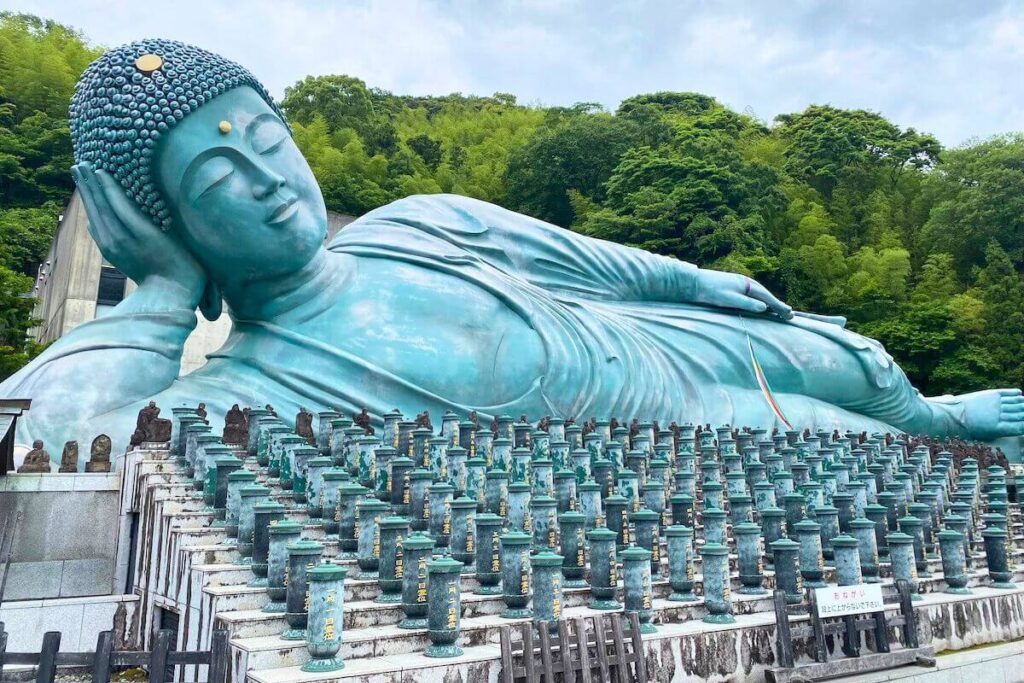
Located about half an hour outside of the city, Nanzoin Temple is home to one of the largest reclining bronze Buddha statues in the world.
Weighing 300 tons, this impressive statue measures 41 meters long and 11 meters tall.
Visitors to the temple are welcome to view the statue, touch the Buddha’s feet for good luck, and even take a short tour inside the structure.
In addition to the reclining Buddha, the temple is home to a beautiful complex that features a number of smaller religious statues, torii gates, gardens, and waterfalls.
Discover Tochoji Temple
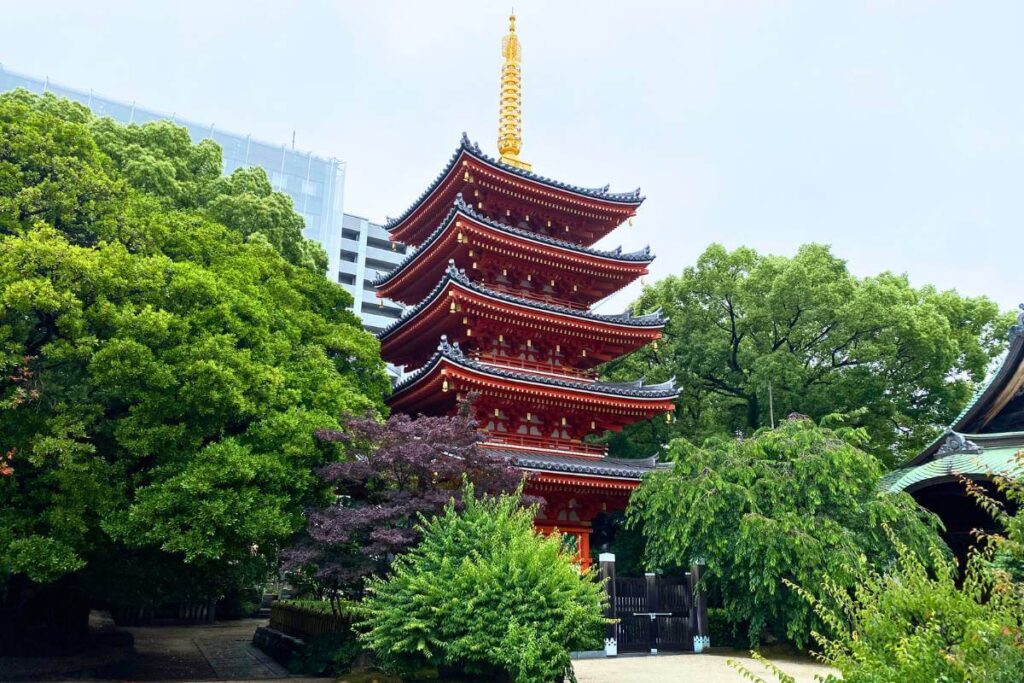
Dating back to 806, Tochoji is one of the oldest Buddhist temples in Japan. It also happens to be home to Japan’s largest wooden seated statue of Buddha.
Measuring 10.8 meters in height, this Buddha weighs approximately 30 tons. While photos of the Buddha are, unfortunately, not allowed, believe me when I say – it’s an impressive sight to behold!
In addition to this, the temple complex is also home to a beautiful five-storied pagoda, a pilgrimage corridor, a main hall, and several smaller structures.
Pro Tip: If you visit Fukuoka in February, be sure to check out the Setsubun Festival at Tochoji Temple. Held each year on the 3rd of February, this festival is meant to ward off evil spirits and bring about good luck!
Visit Kushida-jinja Shrine

Founded in 757, Kushida is Fukuoka’s oldest and most important shrine.
Dedicated to several Shinto deities, the shrine hosts one of the city’s most famous and elaborate festivals, the Hakata Gion Yamakasa Festival.
Held every year during the first two weeks of July, this festival features extravagantly decorated festival floats that tower 10 meters high. These floats are paraded around the city until the festival’s last day, when a final procession brings them back to Kushida.
Don’t worry, though; even if you can’t make it in time for the festival, you can see some of these floats on display at the shrine throughout the year.
Aside from its famous festival, Kushida is also known for its historic structures, which include a corridor of torii gates, a main worship hall, a sacred drinking well, and a 1,000-year-old ginkgo tree.
Explore Sumiyoshi Shrine

Known as a shrine of navigation, Sumiyoshi Shrine in Fukuoka is a famous destination for seafarers and travelers.
Back in the day, when the city functioned mainly as a port town, sailors would stop here in hopes of receiving good luck before heading out to sea.
Today, the shrine’s complex houses several structures, including two sets of red torii gates, several statues, and a main hall that is a designated National Important Cultural Property.
Pro Tip: If you have extra time, be sure to also check out Rakisuien Garden. Situated just across the street, Rakisuien is home to a small traditional Japanese garden and tea house.
Enjoy Canal City Hakata
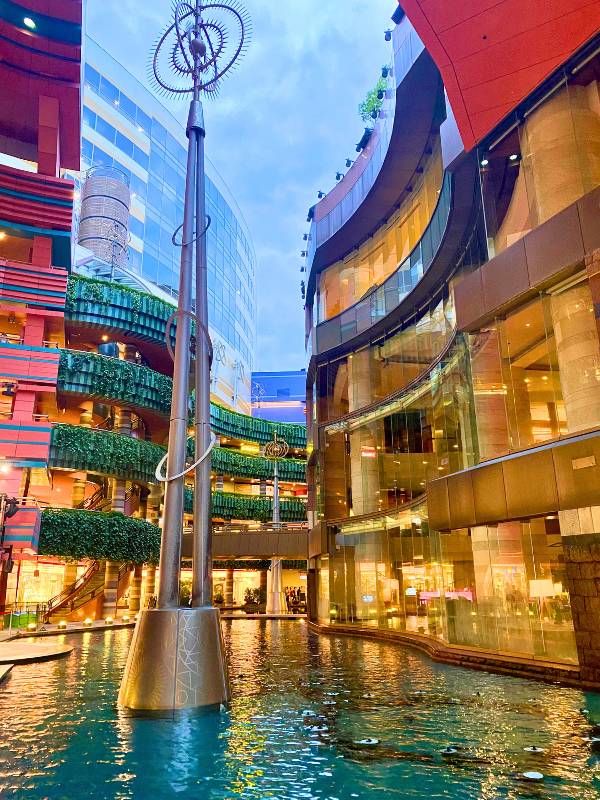

Canal City is probably one of the most well-known destinations in Fukuoka.
And while in theory, it’s simply a large shopping center, it’s almost much more than that.
Built around an artificial canal, Canal City Fukuoka is a five-story complex home to several shops, restaurants, and bars. The most famous of which is Ramen Stadium.
Located on the top floor, Ramen Stadium is essentially a ramen food court. Here, you’ll find 8 ramen restaurants that serve a variety of ramen variations representative of different areas of Japan.
For example, you can get miso ramen from Sapporo here. You can also get tonkotsu ramen from Kurume. And, of course, you can get Hakata ramen from Fukuoka.
In addition to this, Canal City hosts a nightly water fountain show that features a spectacular display of lights and color.
Pro Tip: While you’re here be sure to walk across the street and check out the Yatai food stalls. Famous within Fukuoka, these food vendors offer a variety of delectable local specialities.
Day 3: Day Trip From Fukuoka
On your final day in Fukuoka, we’ll venture outside the city and visit a new destination. Since you’re short on time, I suggest limiting yourself to one destination, so you don’t feel rushed or overwhelmed.
6 Day Trip Recommendations
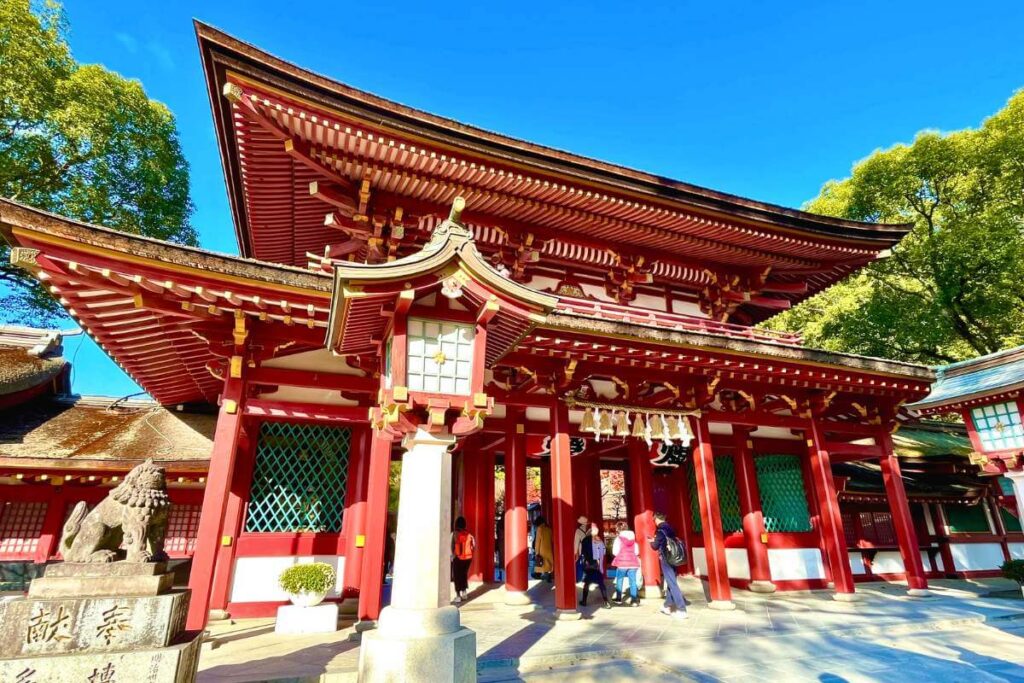
Dazaifu Tenmangu, a Shinto shrine in Dazaifu.
There are countless destination in and around Fukuoka for you to explore. And while they’re all worth visiting, these are some of my favorites:
- Dazaifu: Located approximately 45 minutes outside of Fukuoka, Dazaifu is a small, traditional Japanese city. Dating back to the 7th century, it was once called the “Western Capital of Japan.” Today, it’s home to several historic shrines, temples, and museums.
- Itoshima: Situated about 45 minutes south of Fukuoka, Itoshima is a hidden beach getaway. Here you’ll find several white sandy beaches, blue-green waters, flourishing forests, and an impressive waterfall.
- Yanagawa: Dubbed the “City of Water,” Yanagawa is located about an hour south of Fukuoka. Famous for its historical canals, the city’s guided boat tours are one of the most popular activities among visitors here.
- Beppu/Yufuin: The “Onsen Capital of Japan,” Beppu lies approximately 2 hours east of Fukuoka. The city is famous for its numerous onsens and is home to the highest concentration of hot springs in Japan. And right next to it, you’ll find Yufuin – another destination popular for its onsens and fairytale-like atmosphere.
- Nagasaki: Located about an hour and a half south of Fukuoka, Nagasaki is a historic multicultural city with a tragic past. While its Atomic Bomb Museum and Peace Park are two of the main tourist destinations here, the city is also home to many other attractions. This includes several shrines and temples, as well as one of the largest and oldest Chinatowns in Japan.
- Huis Ten Bosch: A Dutch-inspired theme park, Huis Ten Bosch lies about 2 hours southeast of Fukuoka. Famous for its European settings, this park is home to several amusement rides, shops, restaurants, cafes, and elaborate gardens. The park is also known to host a variety of seasonal events – the most popular of which is Christmas at Huis Ten Bosch.
Other Things to Do in Fukuoka

The Christmas Market in JR Hakata Station Square.
Interested in adjusting the 3-day Fukuoka itinerary suggested above? Or maybe you’d like to stay an additional day? Then consider adding some of these other popular attractions to your itinerary.
- Uminonakamichi Seaside Park: Situated across the bay on a small peninsula, Uminonakamichi is a popular family-friendly destination. There are several attractions here, including a petting zoo, a go-kart track, numerous playgrounds, and a water park.
- Shikanoshima Island: Celebrated for its historical significance, Shikanoshima is the location where one of Japan’s most famous national treasures, the Kinin Golden Block Seal, was found. Today, the island offers a variety of beaches, shrines, and lookout points.
- Nokonoshima Island: Nestled in the midst of Hakata Bay, Nokonoshima is accessible via a quick 10-minute ferry ride. Here, you’ll find an island park, campground, beach, and several locally run restaurants and shops.
- Tenjin Underground Mall: Spanning almost 2,000 feet, the Tenjin Underground Mall is the largest underground shopping area on the island of Kyushu. Connecting Tenjin and Tenjin-Minami stations, the mall is home to approximately 150 shops.
- Visit the Christmas Markets: Throughout the holiday season, Fukuoka hosts a number of festive Christmas markets and illuminations. Some of the most popular events occur at Hakata Station Square, Tenjin Central Park, and Fukuoka City Hall in Tenjin.
Where to Stay in Fukuoka
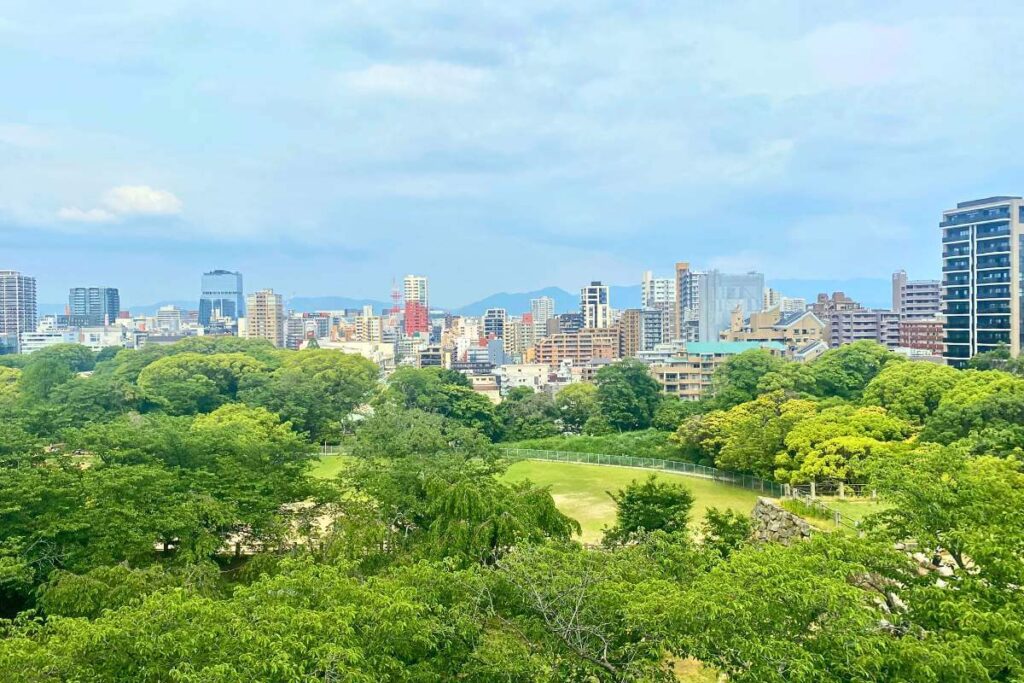
View of Fukuoka from the castle ruins.
Fukuoka is one of Japan’s largest cities, so there are several options for you to consider when it comes to accommodations. Which area you choose will largely depend on your budget, itinerary, and personal preferences. That being said, I’ve included below some of the most popular places to stay in Fukuoka for 3 days.
- Hakata Ward: Centrally located in Fukuoka, Hakata is, without a doubt, the most popular neighborhood in the city. Here, you’ll find many of Fukuoka’s most famous attractions, as well as a number of restaurants, shops, and bars.
- Nakasu Island: An island within Hakata, Nakasu is the best place to stay if you’re in search of nightlife. Known for its numerous bars, clubs, and restaurants, this area is home to the city’s main entertainment district. Please note, however, that Nakasu is not the most family-friendly option, as it also houses the local red-light district.
- Tenjin: Popular among many first-time visitors, Tenjin is another centrally located neighbor that offers easy access to amenities and attractions. Here, you’ll find a diverse mix of restaurants, bars, shops, malls, food markets, and hotels.
- Daimyo: Situated in Chuo Ward, Daimyo is a hip and trendy neighborhood that tends to attract a younger crowd. Offering a more laid-back vibe, the area is known for its vintage shops, cafes, and bars.
- Sawara Ward: Encompassing the neighborhoods of Momochihama and Nishijin, Sawara Ward offers easy access to some of the city’s most famous attractions. This includes Fukuoka Castle, Ohori Park, Fukuoka Tower, and Momochi Seaside Park. The area is very family-friendly and tends to be a bit less crowded than downtown Fukuoka.
What to Eat in Fukuoka
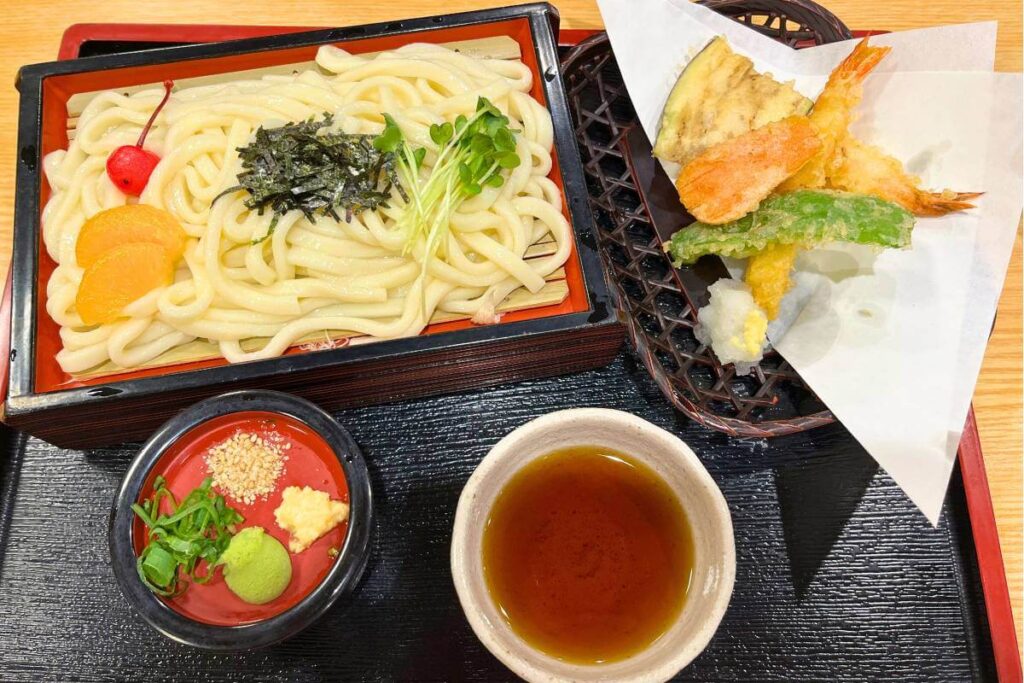
Udon and tempura from a restaurant in Dazaifu.
Fukuoka is an incredible foodie destination! So, believe me when I say you’ll definitely want to set aside some time to sample the local cuisine. While there are countless dishes and restaurants to try, these are some of my favorites.
- Hakata Ramen: Fukuoka was one of the first places to adopt Tonkotsu ramen, which essentially features a pork-bone broth. What makes Hakata ramen (also known as Fukuoka ramen) so special is that they pair this broth with super skinny noodles. This combination may not sound all that exciting, but it is delicious – and growing in popularity.
- Hakata Udon: The udon served in Fukuoka is a bit different than you might expect but still incredibly flavorful. Instead of chewy noodles, Hakata udon features very soft noodles that are served in a clear, refined broth or with a dipping sauce.
- Yatai Food Stalls: Fukuoka is famous for its Yatai food stalls, which feature open-air seating centered around a grill. Here, you can try a variety of local favorites, including ramen, tempura, gyoza, and grilled yakitori skewers.
- Gyoza: Fukuoka is one of the first places where gyoza started to make a name for itself in Japan. Adapted from China’s jiaozi, these bite-sized dumplings are typically filled with ground meat or vegetables and are pan-fried.
- Souffle Pancakes: The souffle pancakes in Japan are incredible – and Fukuoka is no exception! The pancakes here are big, they’re fluffy, they’re jiggly, and they always top my list of recommendations.
- Australian Brunch: Believe it or not, Fukuoka is home to some delicious Australian-inspired cafes and brunch spots. Two of my favorites are bills Fukuoka and Nooice Cafe.
Frequently Asked Questions About Visiting Fukuoka
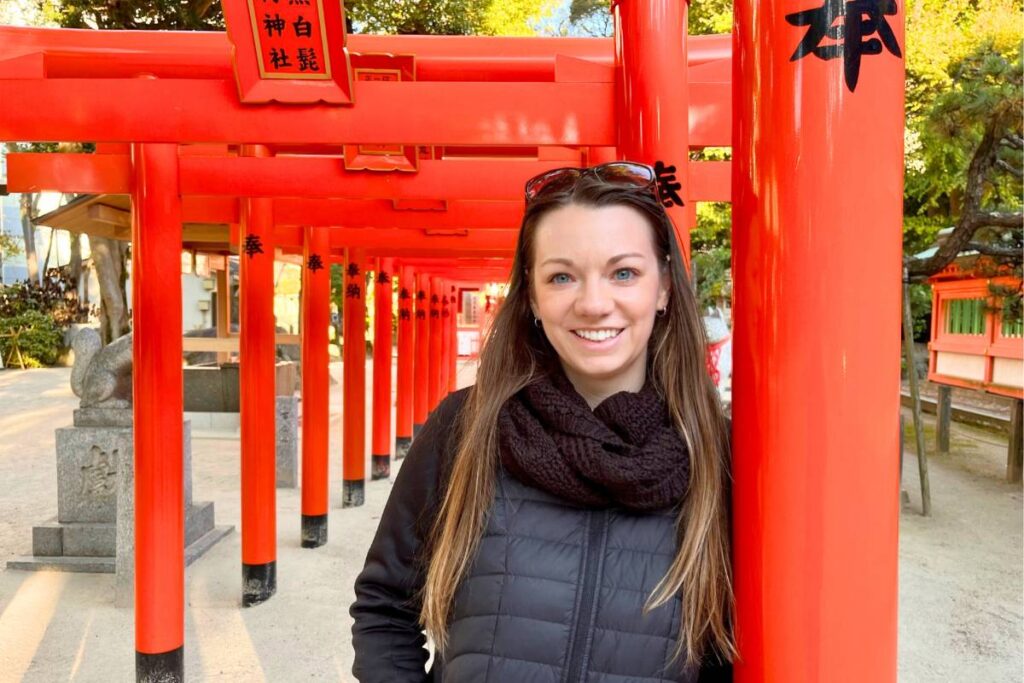
Red torii gates at Sumiyoshi Shrine in Fukuoka.
Here are my thoughts on some commonly asked questions about planning an itinerary for Fukuoka.
Is Fukuoka Worth Visiting?
Absolutely! Fukuoka is one of my favorite Japanese cities! And while it’s a bit out of the way, it’s definitely worth the trip. The city has so much to offer – and the best part, in my opinion, is that it’s not nearly as crowded as Japan’s hot spots. From its vibrant culture to its rich history, delectable food, and beautiful natural surroundings, Fukuoka is a phenomenal destination!
Is 3 Days in Fukuoka Enough?
While you could easily spend weeks exploring all that Fukuoka has to offer, 3 days is the perfect amount of time to check out the highlights and get a feel for the city. With 3 days in Fukuoka, you’ll have just enough time to see the city’s main attractions, sample its incredible cuisine, and experience its vibrant culture.
Is Fukuoka Expensive?
In general, I think Fukuoka is pretty affordable, especially when compared to other popular Japanese cities. While you can find high-end hotels here, there are also a number of affordable capsule hotels and accommodations throughout the city. In addition to this, Fukuoka offers a number of cheap or even free attractions and activities.
How Big Is Fukuoka?
As the capital of Fukuoka Prefecture, the city of Fukuoka is the largest city on Kyushu Island and the sixth-largest city in Japan. It also happens to be the second-largest port city in the country. So, even though it’s not on many foreigners’ radar, the city still plays a pretty significant role within Japan and is a popular place to live.
Which Is Better: Osaka or Fukuoka?
The answer to this question really depends on your interests and travel preferences. While I personally prefer Fukuoka, I definitely see the appeal of Osaka. So again, it really just depends. In short, I’d say that Osaka offers easier access to other Japanese destinations, it has more large-scale attractions (think Universal Studios), and its nightlife is much more lively. On the other hand, Fukuoka is a bit more laid back, less touristy, offers more cultural experiences, and has stunning natural surroundings.
Final Thoughts: 3 Days in Fukuoka
And that wraps up my recommendations for 3 days in Fukuoka! Hopefully, this guide is helpful in planning your own trip to Kyushu’s largest city.
No matter what you decide to do, you’re bound to have an unforgettable time. After all, Fukuoka is an incredible destination, one that offers unique cultural experiences and fun-filled adventures!
Planning your own Fukuoka itinerary for 3 days? What are you most excited to do? Let me know in the comments below!
Love this Fukuoka 3 day itinerary? Pin it now for later!

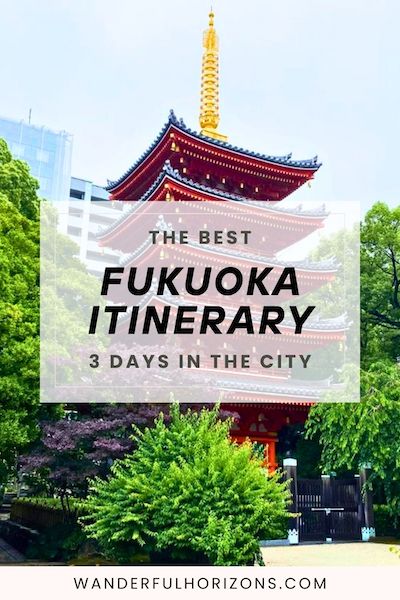
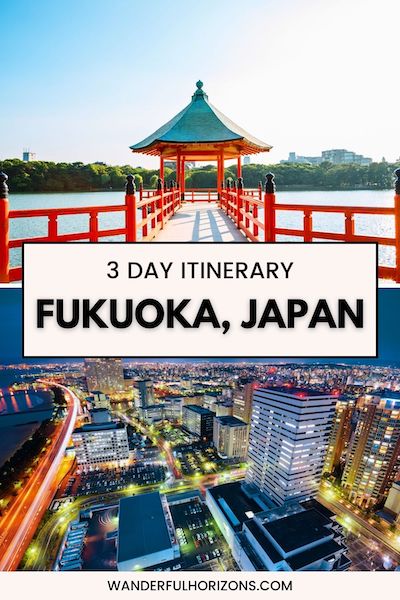

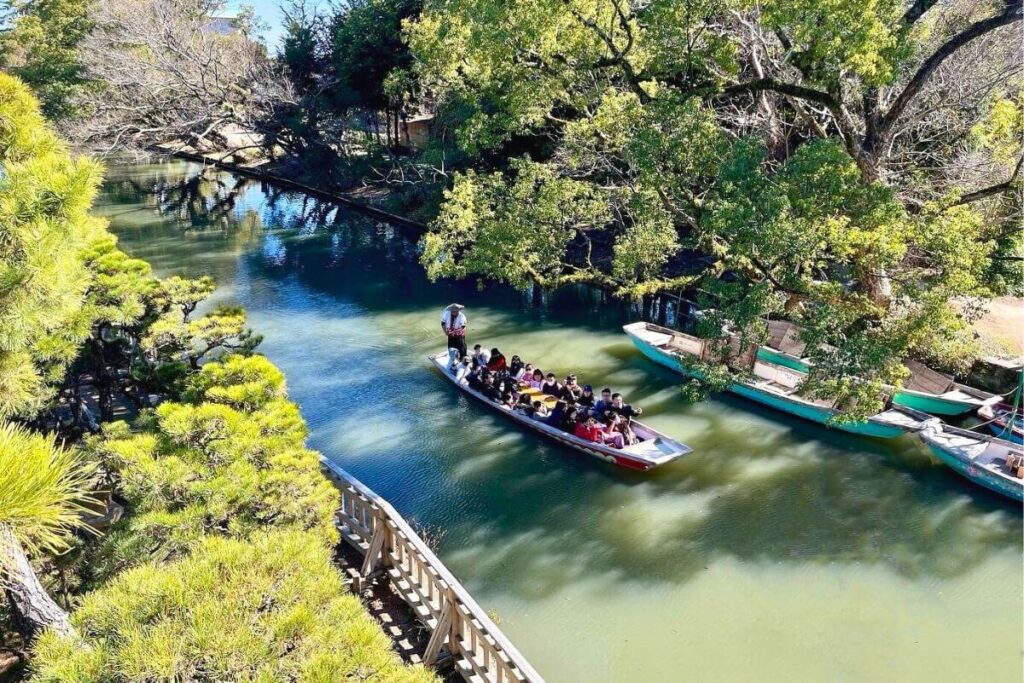
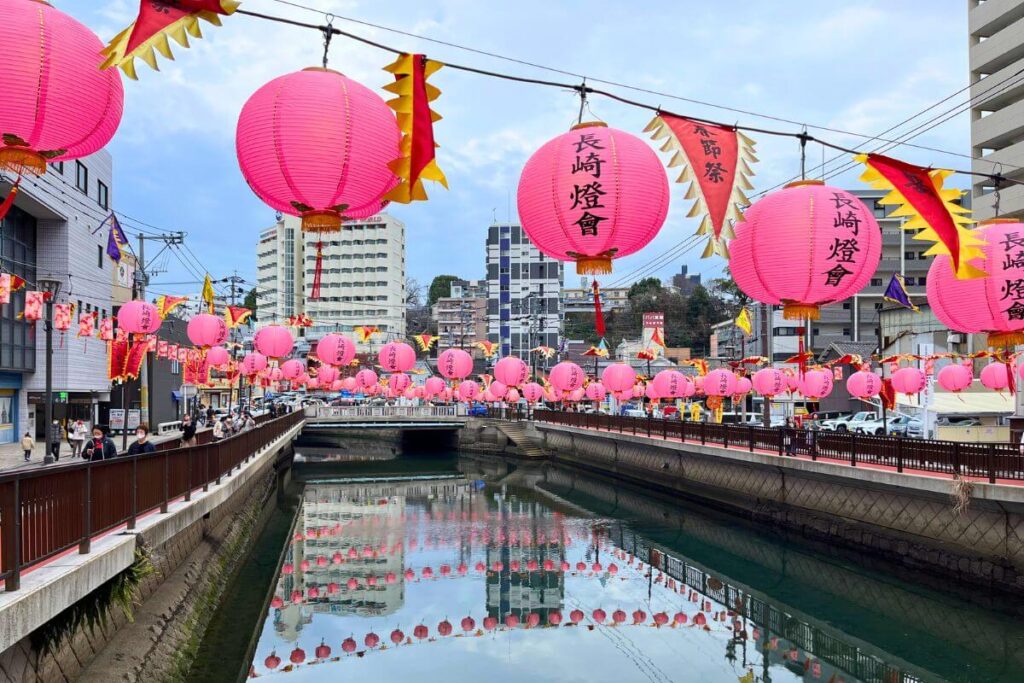
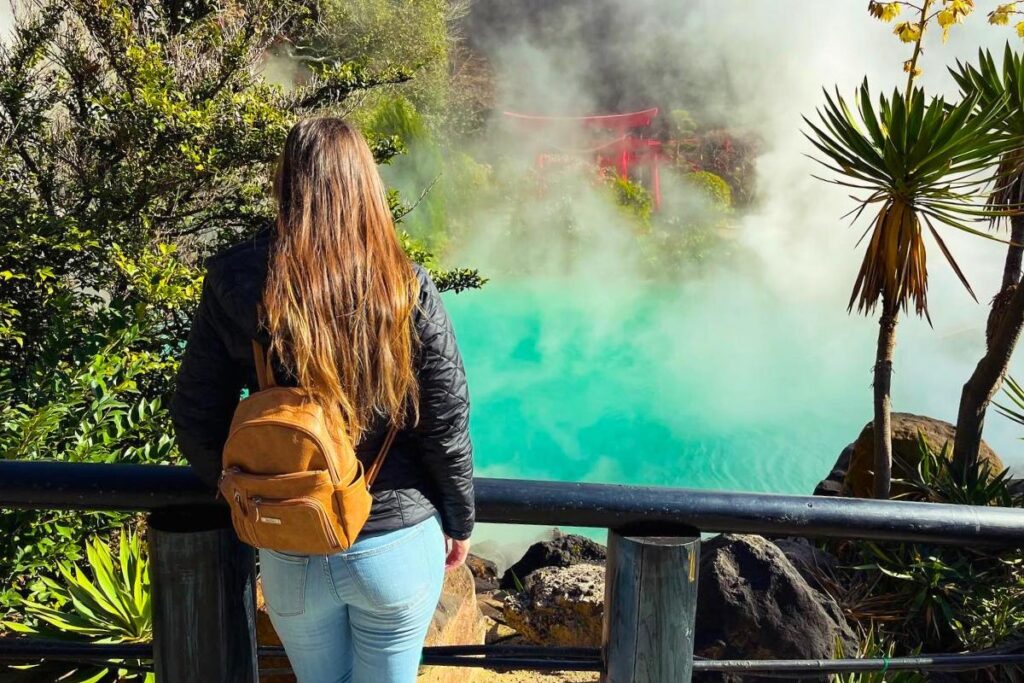
Hi Krysti
I am thinking to visit Fukuoka in about a month time and would like to try the onsen in Beppu/Yufuin . We will mainly relying on JR Pass, do you know if we can reach Beppu/Yufuin easily with public transport or is it better to rent a car etc?
Thanks in advance
Olivia
Hi Olivia,
There’s a limited express train that travels between Fukuoka and Beppu and is covered by the JR Pass. So you should be fine getting there. Once in Beppu, public transportation is available, but it’s by bus only, so it can be a bit more time-consuming. If you plan to just hang out around the main town of Beppu, I think you’ll be fine using the bus. But if you want to explore beyond the main highlights, it would probably be easier to rent a car. Yufuin is also accessible by bus (from Beppu), but it takes significantly longer to get there by bus than it does by car. I hope this helps! I also have a guide on Beppu that you can check out, with more information regarding transportation.
Hope you have an amazing time on your trip – Kyushu is such an incredible destination!